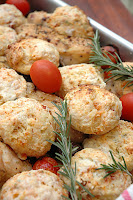 Coq Au Vin in essence is an ordinary French chicken stew, but if you choose
your ingredients wisely, there is nothing ordinary about this dish. In fact, it
is hard to imagine that a few mushrooms, some countryside bacon or lardons, a
delicious red wine and a couple of handfuls of herbs, can become such a
flavorsome stew.
Coq Au Vin in essence is an ordinary French chicken stew, but if you choose
your ingredients wisely, there is nothing ordinary about this dish. In fact, it
is hard to imagine that a few mushrooms, some countryside bacon or lardons, a
delicious red wine and a couple of handfuls of herbs, can become such a
flavorsome stew.The "coq" in Coq Au Vin refers to an old rooster or bird that is traditionally used, because the bones of an older bird, yields such fragrant stock. I am not going to lie to you, honestly, I do not have the time to hunt for "older birds", but I do use Elgin free-range chicken and have never been disappointed, so for me it was the obvious choice. So although in the eye of a coq au vin purist, I may have compromised by not using an older bird, there are other steps in the recipe that I think are as important and you should not skip or alter them. I know that I swore to never make another after the glorious Meraai se Paai which featured here not so long ago, but this is not a pie.....rather an Under Cover Coq a vin! Here goes....
Coq au vin
serves 4
Ingredients
250 gr streaky bacon - diced
8 chicken pieces( I prefer thighs) - with skin and bone
olive oil
salt and pepper
100 ml brandy
1 large onion chopped
1 or two leeks - chopped
1 stalk celery - chopped
2 cloves garlic - chopped
2 T flour
2 T tomato paste
2 cups red wine
2 cups chicken stock
a few sprigs of thyme
1 bay leaf
250 gr button mushrooms
250 gr baby onions - peeled, but kept whole
fresh parsley for serving
Method
Season the chicken pieces with salt and pepper. Heat some olive oil in a cast iron pot and fry the bacon until brown and caramelized. Quickly also brown the little onions in that same pot, remove and keep one side. Remove the bacon from the pot. Add some more olive oil if necessary and brown the chicken pieces on both sides. Remove the chicken from the pot. Preserve about two tablespoons of the oil from the pot. You should now have a thickish brown layer of "flavor" in the bottom of the pot, this is crucial to the flavor of the final dish. De-glaze your pot with the brandy and when all the alcohol has evaporated, add the red wine, chopped onion, celery, leeks, garlic, tomato paste and stock to the pot. Now add the chicken and bacon and make sure each piece of chicken is submerged in the liquid. Turn the heat down and simmer for about 40-45 minutes. Remove the chicken from the liquid and keep warm. Now add the mushrooms and baby onions to the pot and cook for about 10 minutes until the onions are soft and the sauce has reduced somewhat. Mix the preserve fat from the pot with the flour and stir this roux into the sauce, but do it in spoonfuls as you do not want the sauce to be too thick and gluey......
Return the chicken to the pot and allow to just cook through. Serve on buttered noodles or with chucks of crusty bread.
In this case I chose to cover my coq au vin with a blanket of buttery phyllo layers. It adds a lovely crunch to the pie, but also it looks very pretty when served.
Cook's Notes - For the phyllo, simply use three layers of pastry, butter them lavishly with melted butter and lay on top of the coq au vin. Bake for 10 minutes in a pre-heated oven until pastry is golden in color.
 |
|
|







 Nina Timm
Nina Timm











